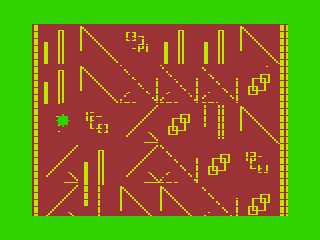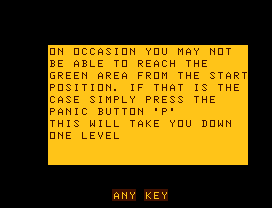Retro Replay Review
Gameplay
Antigravity places you in the role of chief engineer on the starship “Hooray Henry,” facing a high-stakes engine failure during a routine test flight. Rather than conventional narrative interludes, the game leaps straight into action: you guide a lone pixel—your engineer’s echo—through a series of increasingly intricate screens to reach the green sphere that powers the next stage. Each maze-like room represents part of the ship’s engine core, and your pixel must navigate without hitting obstacles that cause you to ricochet off course.
Time pressure is critical. Every level comes with a strict countdown timer, and your final performance is measured by how quickly you achieve the objective. This makes each run tense: one stray bounce into an obstacle and you’ll waste precious seconds correcting your trajectory. Mastering the timing of diagonal motion is the central challenge, as the cursor keys don’t correspond intuitively to the pixel’s movement axes. Learning to anticipate bounces and planning your angle of attack becomes deeply satisfying once you develop muscle memory.
Difficulty scales across multiple screens, from relatively straightforward patterns at the lower levels to mind-bending labyrinths as you progress. There’s no hand-holding: each level’s layout must be studied on the fly, and mistakes are punished with time penalties. Yet the minimalist puzzle design rewards patience and experimentation. For players seeking a gauntlet of precision and reflex-based puzzles, Antigravity’s gameplay loop delivers a niche but addictive challenge.
Graphics
Graphically, Antigravity embraces a stark, retro aesthetic reminiscent of early home-computer titles. The engine room is rendered in simple line art with a handful of contrasting colors—usually monochrome lines on a single-color background. This austerity directs your focus squarely onto the puzzle dynamics rather than visual flourishes, and the result feels like peering at circuit schematics come to life.
However, the game’s implementation in BASIC comes with a cost. Screen-drawing routines are visible during level loads, meaning you’ll sometimes wait several seconds watching the level build line by line. While this loading effect has a certain old-school charm, it can interrupt momentum for modern gamers used to near-instant transitions. If you’re patient enough to see past the loading delays, though, the clean, uncluttered layouts help you quickly identify corridors, barriers, and the all-important green sphere.
The simplicity of Antigravity’s visuals is double-edged: hardcore retro enthusiasts will appreciate the no-frills approach, while those expecting modern polish may find it too bare-bones. Still, the abstract design contributes to a surreal, schematic-like atmosphere that underscores the game’s engineering theme. You’re not traversing a neon corridor or a detailed sci-fi ship hull—you’re navigating the raw logic of an engine testbed, and the graphics reinforce that conceptual feel.
Story
At first glance, Antigravity’s narrative feels like a short premise rather than a sprawling saga: you’re the chief engineer trying to prevent your captain, Dr. Bug-eyes, from losing face after the engine hiccups on a test run. There’s no in-game dialogue, cutscenes, or character development—just you, your pixel avatar, and a ticking clock. The story exists purely as context, setting up your mission to repair the engine from the inside.
Despite its brevity, the premise injects a dose of humor into the proceedings. The name “Hooray Henry” and the caricatured title “Dr. Bug-eyes” hint at a tongue-in-cheek sci-fi romp. Your only narrative reward is the satisfaction of completing levels quickly, saving the captain’s reputation and avoiding the indignity of being towed back to base. That meta-goal provides a quirky charm in lieu of a traditional plot.
For gamers who value narrative depth, Antigravity may feel thin. But if you appreciate a light setup that justifies the puzzling action without weighed-down exposition, the game’s backstory is perfectly adequate. It offers enough motivation to care about each level’s completion time while leaving the bulk of your attention on puzzle-solving rather than lore.
Overall Experience
Antigravity is a distinctive title that marries precision-based puzzles with a retro, abstract presentation. Its core strength lies in the satisfying tension of navigating tight corridors under a strict time limit. Those who invest the effort to master the diagonal movement and bouncing mechanics will discover a rewarding skill curve that keeps players coming back to shave off more seconds.
On the flip side, the slow BASIC-driven loading screens and minimalist visuals may deter players accustomed to fast-paced, graphically rich experiences. The lack of narrative depth or modern conveniences (like save points or tutorials) further positions Antigravity as a game for dedicated puzzle enthusiasts or nostalgia seekers. Casual gamers might find it too austere or unforgiving.
In the end, Antigravity stands out as a quirky piece of retro game design. If you thrive on tight timing, abstract puzzles, and the challenge of mastering an idiosyncratic control scheme, you’ll appreciate its unique flavor. For anyone seeking flashy production values or deep storytelling, this title may prove too sparse. But for its intended audience, Antigravity delivers a lean, engaging experience that harkens back to an era of pure gameplay focus.
 Retro Replay Retro Replay gaming reviews, news, emulation, geek stuff and more!
Retro Replay Retro Replay gaming reviews, news, emulation, geek stuff and more!









Reviews
There are no reviews yet.